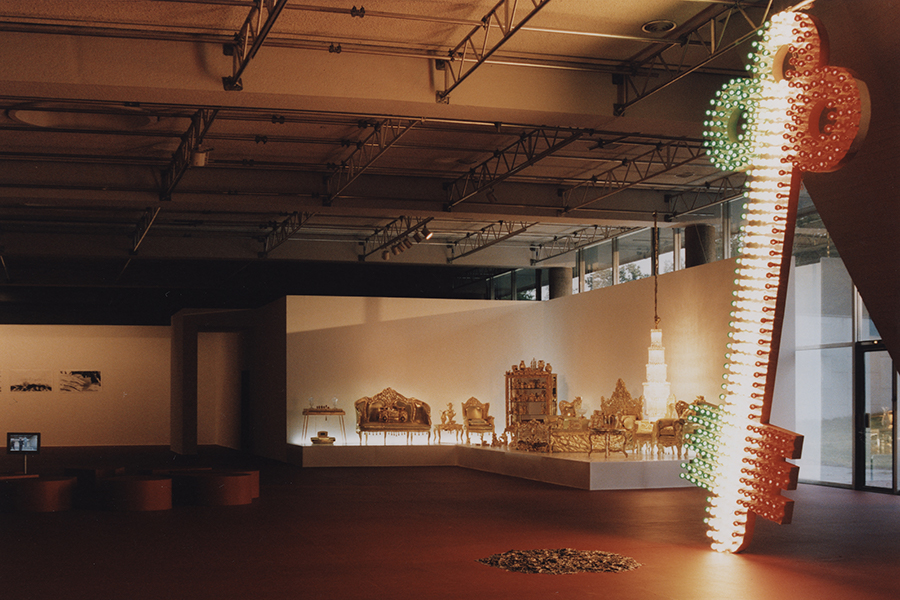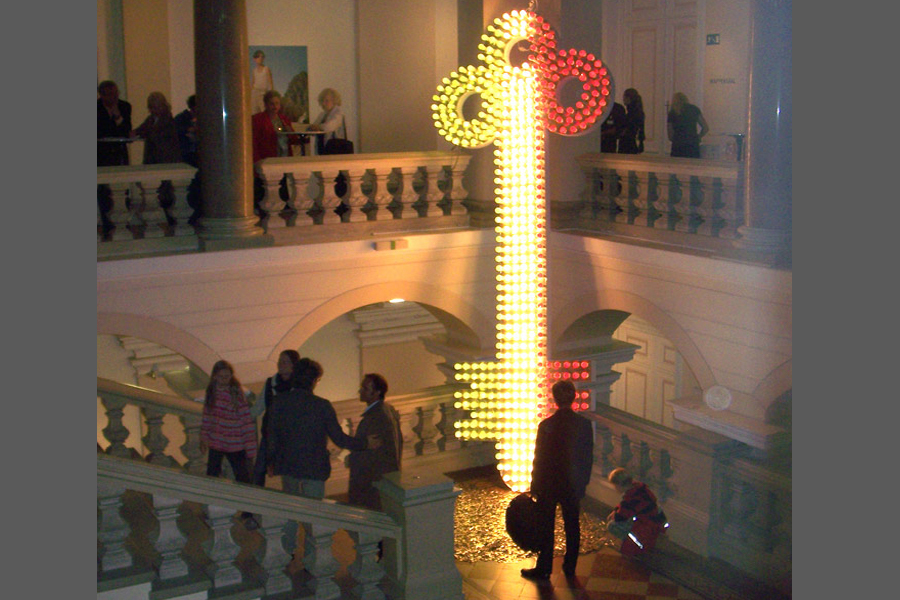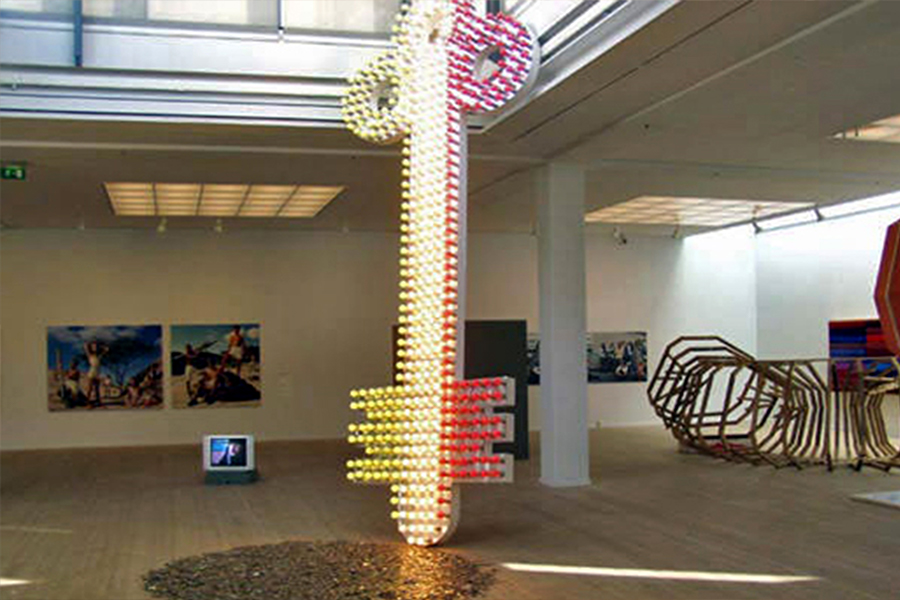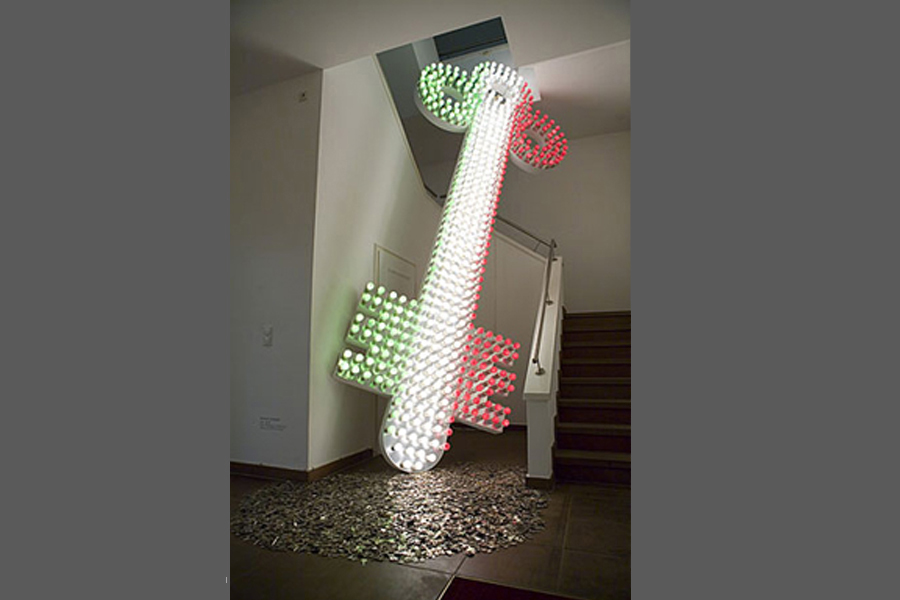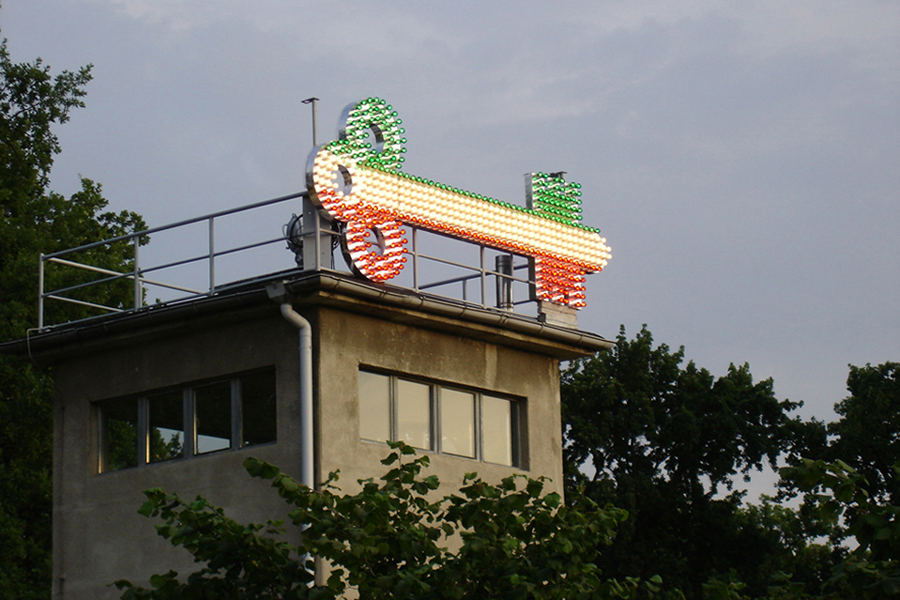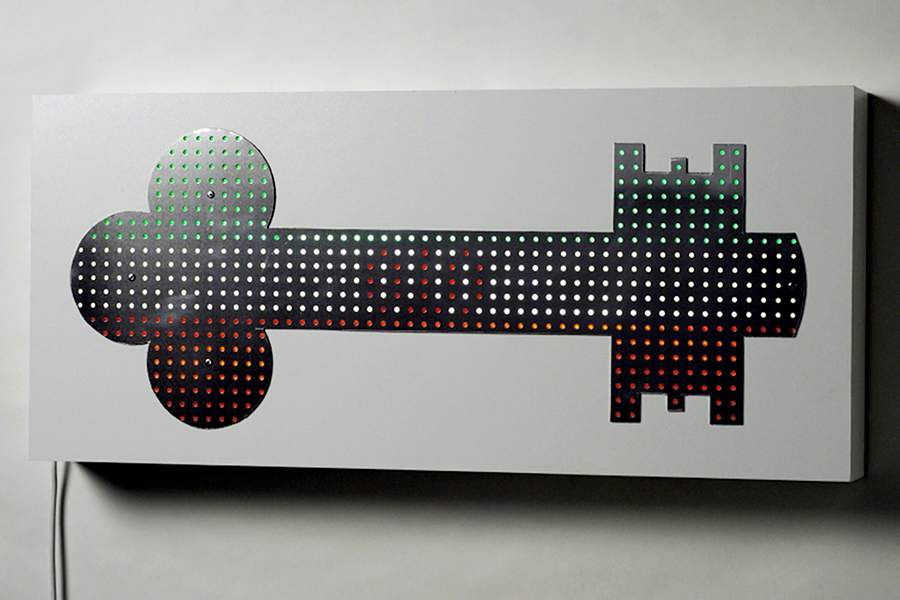Kilid کلید (key) Mixed Media - Installations
Installation: Aluminium board, 150 colored bulbs in green, white, and red, keys, 640 x 260 x 25 cm.
Light, colour, hyperbolic scale: a monumental installation in the shape of a key with light-letters and objects inside it. I recall as many awful kitschy Christmas decorations in the front gardens of wealthy American homes in exclusive neighbourhoods. There, too, the American flag blatantly appears alongside Father Christmas. Light is a tool for perception, but it can also be used to deceive the eye. Colours are joyful aspects of everyday life, but they can also be used as symbols, and invoke a partisanship the consequences of which are often ill understood.
There is no direct causal relationship between such rallying lights and young people’s willingness to fight, kill and die for what those bright colours stand for that they loved as children. But Bush’s youngsters respond to that appeal, as do Allah’s adolescent fans. The keys lying around this gallery floor key us in on what happens between those two moments in life. The indirect link is seduction.
Many cultures have martyrs who have been seduced into willingness to die in the name of some grandiose power that shines brightly and beautifully with promises of belonging. To call this sordid waste of human life martyrdom points to something that is not exclusively a Muslim tool of seduction: the conjunction of religion and nation, the former misused as a promise that the latter cannot deliver. Paradise is one word for the fiction on the other side of the key, freedom another.
Mieke Bal
Professor at Royal Netherlands Academy of Arts and Sciences
"Security advice: Please watch out for abandoned objects and luggage in trains and at platforms. Use the SOS Telephone to inform us."
This line accompanies the current programme of the “Berliner Fenster” [Berlin window], the public transportation TV of the capital’s subways, since the bomb attacks in London have happened. It is the subtitle of commercials, stupid celebrity news and recommendations for mostly third-class events and cooking recipes. The „Berliner Fenster“: involuntary medium of a cynic realism between murder, threat, kitsch, war, security advices, infotainment and advertisement.
The safety measures remind us of opening an umbrella after everybody has gotten wet already. Who is shooting or bombing, when, and why? How is ideology legitimated? How does one decline fundamentalism? What is the rationale for national security?
At the former physic border of the allied forces of the cold war, the former inter-German dividing line of two socially organised ideologies, and one of the last watchtowers of the former GDR in Berlin, is where the work „kilid“ of the artist Shahram Entekhabi, born in Iran, is shining. A six meter-long key (kilid, key in English), made of aluminium and equipped with 400 light bulbs, colored in the colors of the Iranian flag with the image of the tulip of Allah, is shining over the former border area and marks the current ideological border, a border that is embattled in a hot and severe war.
Once the one enmity is overcome, the next one is immediately emerging. The ideology of Islamic fundamentalism confronts the ideology of a hysteric, industrialized Christianity and the societies derived from it.
Entekhabi’s „kilid“ is also to be understood as a symbol and a reference to the small plastic keys, handed to children soldiers in the Iraqi/Iranian war. They were handed to them as the key to the otherworldly paradise to equip them also in a ideological way for martyrdom, before the children were used as human mine detectors. The bombs tear up bodies, souls seek refuge in paradise. At the watchtower, visitors will find countless used original keys, which do not lock or open any lock anymore. Every visitor may choose one and take it home.
Entekhabi’s work, reminding of neon advertisement signs, the aesthetics of fairs and village festivals, casts a new light on the watchtower, the remains and current symbol of a past, formerly proud, industrialized security system.
What is more cruel: the development of weapons that can – like in a computer game - finally be navigated unmanned by the generation of Playstation-Maniacs, suggesting a clean war, or the seduction of children, youngsters, and adults to volunteer as victims and weapons? The entry to Allah’s heart is paid as reward.
The industrial and digital weapon technology serve the game of the weapon industry in its battle for markets, where functionality is checked in the reality-test of current crisis and war regions. The fanatic religiousness serves the mullahs to secure their power interests.
Who is shooting and bombing, when, and why? How is ideology legitimated? By installing Shahram Entekhabi’s work on the watchtower, new fields of interpretation and reference for his work as well as for the tower as historic remains will emerge.
Mari Brellochs
Berlin based art critic, artist, and curator
Kilid (clé), 2004, Installation: Pendant la guerre entre l'Iran et l'Iraq on donnait aux jeunes qui avaient été chargés de déblayer les champs de mines des clefs en plastique pour qu'ils puissent ouvrir la porte du paradis dans le cas d'une mort de martyr.
اثر شهرام انتخابی نيز، که در سال ۱۹۶۳ در بروجرد متولد شده و اکنون در برلين اقامت دارد، از جنبه های فوق العاده انتقادی برخوردار است. زنجيره لامپ هائی به رنگ های سبز و قرمز و سفيد، بر سطح کليدی عظيم می درخشند. برپای اين کليد عظيم که ارتفاع آن به شش متر می رسد، انبوهی از کليدهای کوچک بر زمين ريخته اند. اينجا هم، چنان که اغلب در مورد هنرمندان ايرانی متداول است، نزديکی به ادبيات، عنصری است تعيين کننده، زيرا آدم بايد حکايتی را بشنود تا بتواند مفهوم کار را بفهمد. در عين حال، يک جمله برای اين امر کافی است: به کودکانی که پس از جنگ ايران و عراق به جست و جوی مين می رفتند، کليدی پلاستيکی داده می شد تا اگر يکی از مين ها منفجر شد، به وسيله آن بتوانند دروازه
بهشت را بگشايند
کليد بهشت در خانه فرهنگ های جهان! نقد فرانکفورتر روندشاو
2007: Kilid, Final inspection — curated by Mari Brellochs, former GDR-watchtower at Schlesischer Busch, Kunstfabrik am Flutgraben e.V., Berlin, Germany (solo show)
2007: War of the Buttons — Children and the World of War, curated by Dr. Martin Hochleitner, Århus Kunstbygning Center for Contemporary Art, Århus, Denmark
2006: Krieg der Knöpfe — Kinder und die Welt des Krieges, curated by Dr. Martin Hochleitner, Ursula Blickle Stiftung, Kraichtal-Unteröwisheim, Germany (catalogue)
2006: Krieg der Knöpfe — Kinder und die Welt des Krieges, curated by Dr. Martin Hochleitner, Landesmuseums, Linz, Austria (catalogue/ Book)
2004: Entfernte Nähe /Far Near Distance: Neue Positionen Iranischer Künstler /Contemporary Positions of Iranian Artists, curated by Rose Issa — Haus der Kulturen der Welt, Berlin, Germany (catalogue)
Kilid (EDITION)Edition 5 Erstfeld, switzerland
